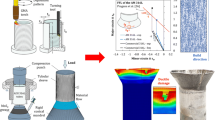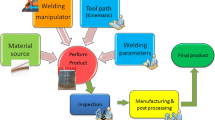Abstract
A die-less method to manufacture tubes by diffusion bonding of rods made of tungsten heavy alloys was developed and characterized. Tungsten heavy alloys are pseudo-alloys of tungsten (W) with small amounts of lower-melting-point binder metals, typically Ni and Fe, and they are widely used in tubular shapes. Due to the excessively high consolidation temperature for W, the fabrication of components is normally done by sintering of powder compacts. During the sintering of W–Ni–Fe alloys, the partially melted Ni–Fe binder metal wets the tungsten powder particles and provides a soluble diffusion network for rapid sintering. However, as the binder metals partially liquefy, this process results in gravity-induced slumping, leading to distortion near the bottom section of the tubular part. This gravity-induced slumping creates significant difficulties during the production of tubular structures. A rod shape is the most stable shape to avoid slumping during sintering. Thus, a method to manufacture tubular tungsten heavy-alloy parts via joining of sintered rods by diffusion bonding was developed. Using an analytical model, the dimensions of the unit rods for fabrication of the target tube shape have been designed. An industry-applicable tube manufacturing process was well characterized, and the feasibility of the process was confirmed.












Similar content being viewed by others
References
German RM, Suri P, Park SJ (2009) Review: liquid phase sintering. J Mater Sci 44:1–39. https://doi.org/10.1007/s10853-008-3008-0
Liu J, German RM (2001) Grain boundary sliding and component shape distortion during liquid-phase sintering. Metall Mater Trans A 32:2087–2095. https://doi.org/10.1007/s11661-001-0020-2
Shen J, Campbell L, Suri P, German RM (2005) Quantitative microstructure analysis of tungsten heavy alloys (W–Ni–Cu) during initial stage liquid phase sintering. Int J Refract Met Hard Mater 23:99–108. https://doi.org/10.1016/j.ijrmhm.2004.10.004
Das J, Kiran UR, Chakraborty A, Prasad NE (2009) Hardness and tensile properties of tungsten based heavy alloys prepared by liquid phase sintering technique. Int J Refract Met Hard Mater 27:577–583. https://doi.org/10.1016/j.ijrmhm.2008.08.003
Dinçer O, Pehlivanoğlu MK, Çalişkan NK, Karakaya İ, Kalkanli A (2015) Processing and microstructural characterization of liquid phase sintered tungsten–nickel–cobalt heavy alloys. Int J Refract Met Hard Mater 50:106–112. https://doi.org/10.1016/j.ijrmhm.2014.12.009
Kekana N, Shongwe MB, Johnson OT, Babalola BJ (2019) Densification behaviour and the effect of heat treatment on microstructure, and mechanical properties of sintered nickel-based alloys. Int J Adv Manuf Technol 103:2227–2233. https://doi.org/10.1007/s00170-019-03698-y
Ghaei A, Movahhedy MR, Taheri AK (2008) Finite element modelling simulation of radial forging of tubes without mandrel. Mater Des 29:867–872. https://doi.org/10.1016/j.matdes.2007.03.013
Freitas BJM, Otani LB, Kiminami CS, Botta WJ (2019) Effect of iron on the microstructure and mechanical properties of the spray-formed and rotary-swaged 319 aluminum alloy. Int J Adv Manuf Technol 102:3879–3894. https://doi.org/10.1007/s00170-019-03449-z
Simonetto E, Ghiotti A, Bruschi S (2017) Dynamic detection of tubes wrinkling in three roll push bending. Procedia Eng 207:2316–2321. https://doi.org/10.1016/j.proeng.2017.10.1001
Kil TD, Lee JM, Moon YH (2015) Quantitative formability estimation of ring rolling process by using deformation processing map. J Mater Process Technol 220:224–230. https://doi.org/10.1016/j.jmatprotec.2015.01.006
Kim SY, Joo BD, Shin S, VanTyne CJ, Moon YH (2013) Discrete layer hydroforming of three-layered tubes. Int J Mach Tools Manuf 68:56–62. https://doi.org/10.1016/j.ijmachtools.2013.02.002
Yi HK, Pavlina EJ, VanTyne CJ, Moon YH (2008) Application of a combined heating system for the warm hydroforming of lightweight alloy tubes. J Mater Process Technol 203:532–536. https://doi.org/10.1016/j.jmatprotec.2007.09.071
Han SW, Woo YY, Hwang TW, Oh IY, Moon YH (2019) Tailor layered tube hydroforming for fabricating tubular parts with dissimilar thickness. Int J Mach Tools Manuf 138:51–65. https://doi.org/10.1016/j.ijmachtools.2018.11.005
Park JY, Han SW, Jeong HS, Cho JR, Moon YH (2017) Advanced sealing system to prevent leakage in hydroforming. J Mater Process Technol 247:103–110. https://doi.org/10.1016/j.jmatprotec.2017.04.006
Lal GK Hillier MJ (1970) The expansion of a thin free tube in electromagnetic forming. Int J Prod Res 8:59–64. https://doi.org/10.1080/00207547008929829
Park HI, Kim DY, Lee JW, Kim SJ, Lee YS, Moon YH (2016) Effect of an aluminum driver sheet on the electromagnetic forming of DP780 steel sheet. J Mater Process Technol 235:158–170. https://doi.org/10.1016/j.jmatprotec.2016.04.023
Kaibyshev OA, Safiullin RV, Lutfullin RY, Valiakhmetov OR, Galeyev RM, Dutta A, Raghu T, Saha GG (2006) Advanced superplastic forming and diffusion bonding of titanium alloy. Mater Sci Technol 22:343–348. https://doi.org/10.1179/174328406X83932
Assari AH, Eghbali B (2019) Solid state diffusion bonding characteristics at the interfaces of Ti and Al layers. J Alloys Compd 773:50–58. https://doi.org/10.1016/j.jallcom.2018.09.253
Kurgan N (2014) Investigation of the effect of diffusion bonding parameters on microstructure and mechanical properties of 7075 aluminium alloy. Int J Adv Manuf Technol 71:2115–2124. https://doi.org/10.1007/s00170-014-5650-9
Joo BD, Jang JH, Lee JH, Son YM, Moon YH (2009) Selective laser melting of Fe-Ni-Cr layer on AISI H13 tool steel. Trans Nonferrous Met Soc China 19:921–924. https://doi.org/10.1016/S1003-6326(08)60378-7
Jang JH, Joo BD, VanTyne CJ, Moon YH (2013) Characterization of deposited layer fabricated by direct laser melting process. Met Mater Int 19:497–506. https://doi.org/10.1007/s12540-013-3018-6
Senthilnathan N, Annamalai AR, Venkatachalam G (2017) Sintering of tungsten and tungsten heavy alloys of W–Ni–Fe and W–Ni–Cu: a review. Trans Indian Inst Metals 70:1161–1176. https://doi.org/10.1007/s12666-016-0936-2
Wu D, Wei Y Terpenny J (2019) Predictive modelling of surface roughness in fused deposition modelling using data fusion. Int J Prod Res 57:3992–4006. https://doi.org/10.1080/00207543.2018.1505058
Bose A, German RM (1988) Sintering atmosphere effects on tensile properties of heavy alloys. Metall Mater Trans A 19:2467–2476. https://doi.org/10.1007/BF02645474
Jung HK, Kang CG, Moon YH (2000) Induction heating of semisolid billet and control of globular microstructure to prevent coarsening phenomena. J Mater Eng Perform 9:12–23. https://doi.org/10.1361/105994900770346222
Kim ES, Lee KH, Moon YH (2000) A feasibility study of the partial squeeze and vacuum die casting process. J Mater Process Technol 105:42–48. https://doi.org/10.1016/S0924-0136(00)00557-4
Kim DK, Woo YY, Park KS, Sim WJ, Moon YH (2018) Advanced induction heating system for hot stamping. Int J Adv Manuf Technol 99:583–593. https://doi.org/10.1007/s00170-018-2385-z
Hwang TW, Woo YY, Han SW, Moon YH (2018) Functionally graded properties in directed-energy-deposition titanium parts. Opt Laser Technol 105:80–88. https://doi.org/10.1016/j.optlastec.2018.02.057
Song MC, Moon YH (2016) Coupled electromagnetic and thermal analysis of induction heating for the forging of marine crankshafts. Appl Therm Eng 98:98–109. https://doi.org/10.1016/j.applthermaleng.2015.11.129
Cheng B, Lane B, Whiting J, Chou K (2018) A combined experimental-numerical method to evaluate powder thermal properties in laser powder bed fusion. J Manuf Sci Eng 140:111008. https://doi.org/10.1115/1.4040877
Li M, Ruprecht D, Kracker G, Höschen T, Neu R (2018) Impact of heat treatment on tensile properties of 97W2Ni1Fe heavy alloy. J Nucl Mater 512:1–7. https://doi.org/10.1016/j.jnucmat.2018.09.055
Bollina R, German RM (2004) Heating rate effects on microstructural properties of liquid phase sintered tungsten heavy alloys. Int J Refract Met Hard Mater 22:117–127. https://doi.org/10.1016/j.ijrmhm.2004.01.006
Das J, Appa Rao G, Pabi SK (2010) Microstructure and mechanical properties of tungsten heavy alloys. Mater Sci Eng A 527:7841–7847. https://doi.org/10.1016/j.msea.2010.08.071
Şahin Y (2014) Recent progress in processing of tungsten heavy alloys. J Powder Technol Article ID 764306 https://doi.org/10.1155/2014/764306
Humail IS, Akhtar F, Askari SJ, Tufail M, Qu X (2007) Tensile behavior change depending on the varying tungsten content of W–Ni–Fe alloys sinterng time and atmosphere. Int J Refract Met Hard Mater 25:380–385 https://doi.org/10.1016/j.ijrmhm.2006.12.003
Funding
This work was partially supported by a National Research Foundation of Korea (NRF) grant, funded by the Korean government (MSIP) (no. 2012R1A5A1048294).
Author information
Authors and Affiliations
Corresponding author
Ethics declarations
Conflict of interest
The authors declare that they have no conflict of interest.
Additional information
Publisher’s note
Springer Nature remains neutral with regard to jurisdictional claims in published maps and institutional affiliations.
Rights and permissions
About this article
Cite this article
Park, Z.S., VanTyne, C.J., Kim, J. et al. Die-less manufacturing of tube by diffusion bonding of unit rods made of tungsten heavy alloy. Int J Adv Manuf Technol 106, 1213–1221 (2020). https://doi.org/10.1007/s00170-019-04668-0
Received:
Accepted:
Published:
Issue Date:
DOI: https://doi.org/10.1007/s00170-019-04668-0




